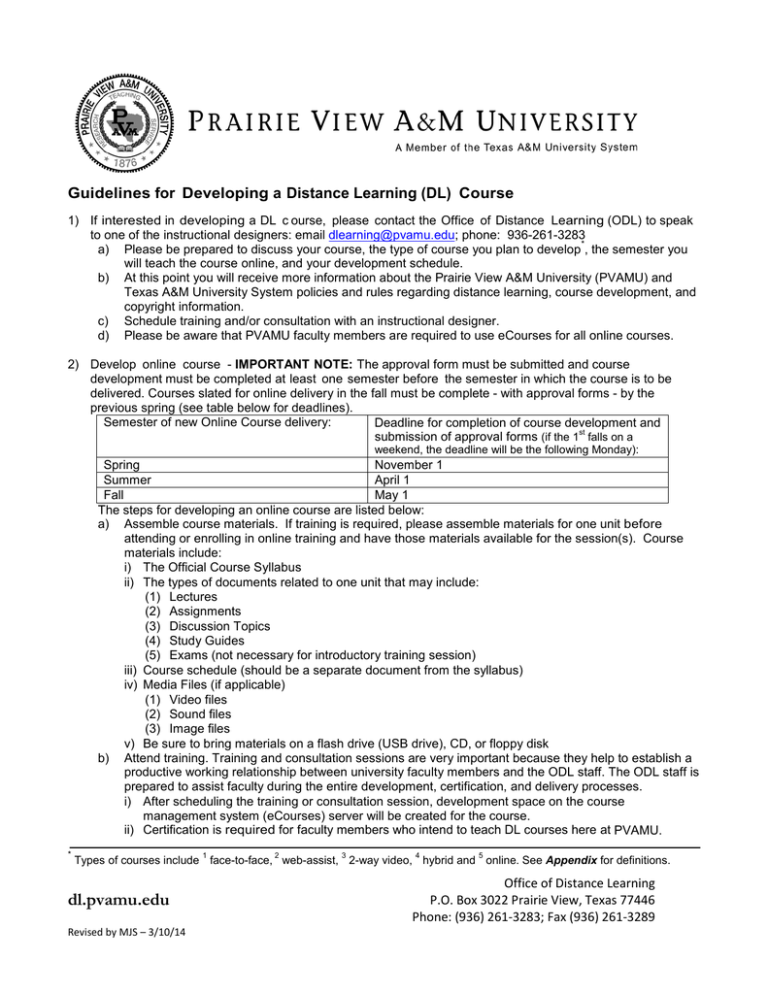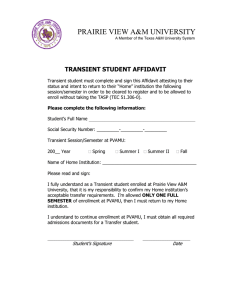Guidelines for Developing a Distance Learning (DL) Course
advertisement

Guidelines for Developing a Distance Learning (DL) Course 1) If interested in developing a DL c ourse, please contact the Office of Distance Learning (ODL) to speak to one of the instructional designers: email dlearning@pvamu.edu; phone: 936-261-3283 * a) Please be prepared to discuss your course, the type of course you plan to develop , the semester you will teach the course online, and your development schedule. b) At this point you will receive more information about the Prairie View A&M University (PVAMU) and Texas A&M University System policies and rules regarding distance learning, course development, and copyright information. c) Schedule training and/or consultation with an instructional designer. d) Please be aware that PVAMU faculty members are required to use eCourses for all online courses. 2) Develop online course - IMPORTANT NOTE: The approval form must be submitted and course development must be completed at least one semester before the semester in which the course is to be delivered. Courses slated for online delivery in the fall must be complete - with approval forms - by the previous spring (see table below for deadlines). Semester of new Online Course delivery: Deadline for completion of course development and submission of approval forms (if the 1st falls on a weekend, the deadline will be the following Monday): Spring November 1 Summer April 1 Fall May 1 The steps for developing an online course are listed below: a) Assemble course materials. If training is required, please assemble materials for one unit before attending or enrolling in online training and have those materials available for the session(s). Course materials include: i) The Official Course Syllabus ii) The types of documents related to one unit that may include: (1) Lectures (2) Assignments (3) Discussion Topics (4) Study Guides (5) Exams (not necessary for introductory training session) iii) Course schedule (should be a separate document from the syllabus) iv) Media Files (if applicable) (1) Video files (2) Sound files (3) Image files v) Be sure to bring materials on a flash drive (USB drive), CD, or floppy disk b) Attend training. Training and consultation sessions are very important because they help to establish a productive working relationship between university faculty members and the ODL staff. The ODL staff is prepared to assist faculty during the entire development, certification, and delivery processes. i) After scheduling the training or consultation session, development space on the course management system (eCourses) server will be created for the course. ii) Certification is required for faculty members who intend to teach DL courses here at PVAMU. * 1 2 3 4 5 Types of courses include face-to-face, web-assist, 2-way video, hybrid and online. See Appendix for definitions. dl.pvamu.edu Revised by MJS – 3/10/14 Office of Distance Learning P.O. Box 3022 Prairie View, Texas 77446 Phone: (936) 261-3283; Fax (936) 261-3289 Page 2 of 8 3) Obtain approval to teach the DL course from College Dean or Department Head. a) Complete course approval forms, b) Submit signed course approval forms to the Office of Distance Learning (ODL) 4) Course Review – Important note: Be sure to allow adequate review time for the course prior to the semester in which the course is to be delivered. a) Notify the ODL when course development is complete and submit the signed Course Approval form. To complete the course approval form, please perform the following: i) Peer review: The course content must be approved by the department’s curriculum committee. At this point, issues such as the course syllabus, subject matter, grammar, and organization are reviewed. After successful review, the curriculum committee chair signs the appropriate line on the course approval form. ii) Department Head review: The department reviews the course and ensures that the answers to the questions in the self-study above are accurate and truthful. After successful review, the department head signs the appropriate line on the course approval form. iii) Dean’s Approval: The dean reviews the self study. If the dean concurs with the recommendation of the curriculum committee and department head, he or she signs the appropriate line on the course approval form. The college dean may require a collegelevel committee to review the course and provide recommendations. b) The Distance Learning Council (DLC) reviews the course and votes on whether or not to approve it. i) The course can be approved as-is or with modifications ii) If modifications are required, the designer/faculty member will be notified and the course will be reviewed again after modifications are made. c) Once the DLC approves the course, the course documentation is forwarded to the Office of Academic and Student Affairs for approval. i) Once approved by the Office for Academic and Student Affairs, the course documentation is forwarded to the University Registrar. ii) The Registrar then adds the approved course to the university course inventory. Notes: 1) In addition to the current cost per semester credit hour, students are currently charged $35.00 per credit hour for DL courses (eg: a three semester hour course would cost an additional $105.00). 2) Any student name changes must be made through the Registrar’s office. 5) Release time Release time is to be provided to PVAMU faculty who develop and teach a course which has not been previously delivered online. As stated in the Distance Learning Plan found on the PVAMU website found at: (http://dl.pvamu.edu/SiteCollectionDocuments/DistanceLearningPlan2005A-revised.pdf) “The assigned faculty member will receive a one-course reduction for the semester in which the development/conversion occurs. In addition, the faculty member presenting the course for the first time will receive a one-course reduction.” Release time is not provided for duplicate course development. A statement on release time can also be found in the PVAMU Finance and Administration Administrative Procedures Manual 80.06.3(Procedures).3.3. 6) Course Delivery Please remember to obtain as much feedback from your students during the course as you can so that adjustments can be made if necessary. Student feedback is very important to the process of making the course as effective and engaging as possible. dl.pvamu.edu Revised by MJS – 3/10/14 Office of Distance Learning P.O. Box 3022 Prairie View, Texas 77446 Phone: (936) 261-3283; Fax (936) 261-3289 Page 3 of 8 The following pages outline the PVAMU guidelines for delivering online courses. The guidelines include information about communication expectations, class, size, and testing. The PVAMU Office of Distance Learning (ODL) developed these guidelines based on standards and best practices employed at other educational institutions that offer online courses as well as the Principles of Good Practice published by the Southern Regional Educational Board. Click the links below to view the guidelines of each topic. Communication Expectations > Class Size > Testing > Proctoring > dl.pvamu.edu Revised by MJS – 3/10/14 Office of Distance Learning P.O. Box 3022 Prairie View, Texas 77446 Phone: (936) 261-3283; Fax (936) 261-3289 Page 4 of 8 Communication Expectations Most of the documentation regarding communication refers to things such as “timely” or “prompt” feedback students. This applies to replying to email and discussion posts and posting grades or providing feedback on activities. It is up to the individual institution, college or department to define what “timely” and “prompt” mean to them. The ODL recommends that instructors respond to student emails and discussion posts as soon as possible but no more than 48 hours from the time they receive them. Students should know what to expect regarding how long it takes the instructor to reply to correspondences. To that end, that information is a required part of the course syllabi for online courses. There is no required maximum time for feedback on activities and posting grades because that time varies depending on class size and the type of activities assigned. However, to relieve some of the anxiety students may already feel because of the physical “disconnect” of the online environment, the ODL recommends giving the students a time frame for when to expect feedback and grade postings when activities are assigned. dl.pvamu.edu Revised by MJS – 3/10/14 Office of Distance Learning P.O. Box 3022 Prairie View, Texas 77446 Phone: (936) 261-3283; Fax (936) 261-3289 Page 5 of 8 Class Size This has been a point of contention between faculty and administration for a long time, even in the traditional classroom setting. While there is no hard-and-fast rule regarding class size, the ODL recommends a cap of 20 students for online courses. However, the optimal class size really depends on the nature of the course and the strategies that instructors employ to manage their courses. For this reason, the individual departments have the final say regarding class size. There are several things to consider when setting class sizes for online courses. A collaborative, learner-centered approach may be able to accommodate more students. That approach, however, may not be ideal for every course. A course that requires each student to complete multiple research papers and projects might work best with a smaller class size so that instructors can evaluate work and give feedback in a timely fashion. dl.pvamu.edu Revised by MJS – 3/10/14 Office of Distance Learning P.O. Box 3022 Prairie View, Texas 77446 Phone: (936) 261-3283; Fax (936) 261-3289 Page 6 of 8 Testing Online exams should be similar to corresponding exams in face-to-face (F2F) courses when it 6 comes to content and duration. However, in an asynchronous online course (PVAMU’s online courses are asynchronous), proctoring and scheduling should be taken into consideration. Students enroll in online courses for time flexibility as well as distance issues. For this reason, the ODL recommends an availability period of at least 24 hours to accommodate students’ varying schedules. If instructors are reluctant to make a test available for 24 hours or more for fear of compromising test security, they must use their own discretion to determine availability times. They are required to inform students of testing dates and times well in advance – preferably at or near the start of the term – so that students can make the necessary arrangements to take the test. Instructors choose whether or not to require a proctor for their exams. If there is a proctor requirement, it should be made clear in the syllabus. The syllabus should also outline any specific criteria that proctors are required to meet. If students read the syllabus (as they should) at the beginning of the semester, they can then decide if the proctoring requirement would dissuade them from taking the course in time to drop the course and add another. dl.pvamu.edu Revised by MJS – 3/10/14 Office of Distance Learning P.O. Box 3022 Prairie View, Texas 77446 Phone: (936) 261-3283; Fax (936) 261-3289 Page 7 of 8 Proctoring The PVAMU guidelines for proctoring are as follows: 1. The student is responsible for identifying a proctor in or near his or her city. o The ODL recommends a professional testing center or a testing center within an educational institution. Instructors have approved libraries in the past, but it is important to note that many libraries are unable to guarantee that an individual will be on hand to watch the student to make sure no cheating occurs. o The testing site must be able to provide a PC with Internet access if the student is to take the exam via eCourses. 2. The student must provide the ODL and the instructor with contact information that can be used to verify the location and identity of the proctor. A name, phone number, email address, and website are required. The person verifying the proctor should be able to find the proctor in the institution’s directory to verify that he or she is an actual proctor at the testing site. 3. Instructors have the final say on whether or not a proctor is acceptable. The instructor can overrule the ODL either way. 4. The ODL recommends that the instructor send the proctor a text-based version of the exam that can be printed out in case there are any technical issues. In that case, the student would submit the completed hardcopy to the proctor and the proctor would mail – and/or scan and then email – the completed exam to the instructor. 5. The student is responsible for any fees required by the testing site. dl.pvamu.edu Revised by MJS – 3/10/14 Office of Distance Learning P.O. Box 3022 Prairie View, Texas 77446 Phone: (936) 261-3283; Fax (936) 261-3289 Appendix 7 1. Face-to-Face (F2F): A F2F course is a traditional, synchronous in-person course. Students and instructors are required to meet in the location and at the date and time published in BANNER / PantherTracks. F2F courses do NOT require approval from the Distance Learning Council. 2. Web-Assist: A web-assist course is traditional synchronous course that is supplemented with online content posted to eCourses. Instructors can post as much or as little content to eCourses as they choose. Students and instructors are required to meet in the location and at the date and time published in BANNER / PantherTracks. Web-assist courses do NOT require approval from the Distance Learning Council. If activities are placed in eCourses for a web-assist course, it is highly recommended that the instructor provides alternative submission methods in case technical issues interfere with students’ ability to submit or complete activities online. 3. 2-Way Video: A 2-way video course is a synchronous course that is delivered in two different physical locations simultaneously and linked by a live 2-way video connection. The students and instructors are required to meet in the locations and at the date and time published in BANNER / PantherTracks. 2-way video courses REQUIRE approval from the Distance Learning Council. 4. Hybrid: A hybrid course is a course which a majority (more than 50 percent but less than 85 percent) of the planned instruction occurs when the students and instructor(s) are not in the same place. eCourses is used for the posting of materials online. The location and schedule of inperson meetings and online activities are pre-arranged by the instructor and clearly communicated to students at the start of the semester in a published course schedule and syllabus. Hybrid courses REQUIRE approval from the Distance Learning Council. 5. Online course: An online course is an asynchronous course delivered fully online. Instructors post all course content on eCourses. An online course may have mandatory F2F or synchronous sessions totaling no more than 15 percent. Examples of F2F sessions include orientation, laboratory, exam review, or in-person tests. If F2F or synchronous sessions are required, this information must be clearly communicated to students at the start of the semester through email, a published course schedule and/or course syllabus. Early notification gives students residing in distant geographical locations enough time to either make the necessary arrangements to participate or unenroll from the course without penalty. Alternative participation methods (including real-time webinars or similar technology) should be explored to accomodate students residing in distant geographical locations enrolled in an online course with mandatory F2F sessions. Online courses REQUIRE approval from the Distance Learning Council. 6. Asynchronous: In asynchronous environments, interaction DOES NOT occur simultaneously. Students and/or instructors interact at different times in a virtual environment. An example of an asynchronous environment is a discussion board or email communication. 7. Synchronous: In synchronous environments, interaction occurs simultaneously. Students and/or instructors interact at the same time in a common physical or virtual environment. An example of a synchronous environment is a classroom meeting, a chat room or a live webinar. Revised by MJS – 3/10/14


